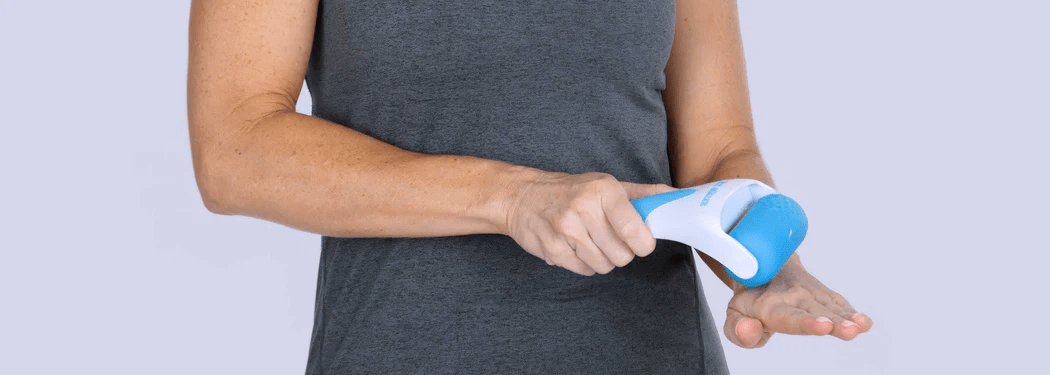Home Remedies & Ways to Find Carpal Tunnel Relief
Carpal tunnel causes numbness and a tingling sensation along with weakness in your hand, arm and wrist that often develops and worsens overtime with repetitive motions and use. Fortunately, there are many options when it comes to carpal tunnel treatment – from home remedies and lifestyle changes, to drug and surgical procedures for more serious conditions. Keep reading to learn ways you can start relieving and preventing pain today. For chronic or lasting pain, talk with your doctor to determine the best methods for relief.
At Home Carpal Tunnel Treatment
Home remedies for carpal tunnel syndrome focus on reducing swelling around the nerve and offering pain relief. These simple remedies can be done in the comfort of your own home. However, if you have pain that is increasing or doesn’t get better with treatment we recommend getting medical advice from your doctor.
Hand and Wrist Exercises
Another one of our favorite at-home remedies are hand and wrist exercises. Exercises can lower your chance of requiring surgery and will strengthen forearms, wrists, and grip strength. They are simple to do anywhere and require no specialized equipment. Unlike gym strength training, carpal tunnel stretches and exercises should be stopped if you are uncomfortable or feel pain. Advance slowly to help reduce wrist pain and other symptoms of carpal tunnel syndrome.
Exercises and Stretches for Carpal Tunnel
Massage
Not well known, but potentially effective treatment for carpal tunnel syndrome is massage. A trained massage therapist can loosen muscles, relax joints, and trigger points. When applied to the wrist and surrounding area you may feel less carpal tunnel symptoms. Combining this nonsurgical treatment with other at-home options will give better results.
Massage for Carpal Tunnel
Wear a Wrist Support
A wrist splint will keep your wrist in a neutral position to prevent further irritation to the median nerve. By reducing the irritation you’ll have less pain and numbness, two of the key symptoms of carpal tunnel syndrome. Splinting can be done anytime of day or night and during almost any activity. You’ll receive the greater benefit from the splint the more you wear it.
There are two options when choosing a wrist support splint. A daytime wrist splint is perfect for wearing all day, while at work and at home. It will eliminate or greatly reduce pressure within your wrist by keeping your wrist straight. A night wrist splint will restrict bending within your wrist while you sleep. These splints tend to be more comfortable for nighttime use than their daytime counterpart and help to relieve carpal tunnel pain at night.
Elevate Hands
Part of the physiology behind carpal tunnel syndrome is inflammation around the median nerve. This means that swelling is happening around the nerve that goes through your wrist. The swelling causes pressure on the nerve which in turn causes pain. Elevation is one of the most effective and simplest strategies to combat swelling. Put your hands on a pillow above the level of your heart. Try this while at home while you’re watching TV or sleeping.
Cold and Hot Therapy
Icing an injury reduces swelling and pain, while heat brings more blood to the injury site. Both of these treatment options can be done at home with minimal additional equipment.
Cold therapy uses ice packs or cold water baths. The cold causes vasoconstriction of the blood vessels and numbs the pain. Vasoconstriction is when the blood vessels tighten, which in turn reduces swelling. An ice pack is an inexpensive, portable treatment option.
Hot therapy can be done through a heating pad, a warm soak, or with specialized fingerless gloves. Warmth stimulates blood flow to the area, bringing nutrients and oxygen to improve healing. You can use a heating pad on top of your hands to warm the wrists. If you are on the go, carpal tunnel gloves are a great choice. These compression gloves hold in heat while letting you go on with your daily activities. They are also commonly worn by people with rheumatoid arthritis to reduce swelling and pain.
Ice or Heat for Carpal Tunnel
Use Pain Relief Cream
If you’re looking for a quick fix, then pain relief cream is one option for you. Most creams provide a cooling sensation, similar to cold therapy that numbs wrist pain. Pain relief is typically felt for 30 minutes or more. These creams are a short-term solution that can be used in conjunction with other carpal tunnel treatment. We recommend finding a pain relief cream that is non-greasy and won’t stain your clothes.
Kinesiology Tape
One of the causes of carpal tunnel syndrome is overuse from racquet sports, like tennis. If you’re having pain while playing sports using kinesiology tape provides support when applied properly and won’t get in the way of your game. The breathable tape is strategically positioned over your hand and wrist to help reduce swelling.
How to Use Kinesiology Tape for Carpal Tunnel
Lifestyle Changes for Carpal Tunnel Relief
So much of what you do every day affects your body, including your wrists. A lifestyle that includes healthy food, exercise, and avoiding smoke reduces your risk factors for developing chronic conditions.
Adapting Your Work Space
- If you work in an office, keep your hands and wrists in a neutral position. Adjust your chair or computer to the proper height and use an ergonomic mouse or wrist rest to prevent improper positioning.
- Make sure you have correct sitting posture, with your back straight, shoulders up, and feet flat on the floor. Try using a lumbar support cushion to maintain proper posture at your desk.
- For those who do manual labor change up repetitive motions and avoid tools that vibrate, like drills.
Take Breaks from Repetitive Activities
Repetitive activities can irritate carpal tunnel. Take frequent breaks to let your wrists rest or perform carpal tunnel stretching exercises every so othen to loosen ligaments and avoid nerve irritation. People who have jobs that involve construction, assembly work, and keyboards tend to have higher rates of carpal tunnel syndrome.
Avoid Over Flexion of the Wrist
Your median nerve sits in a small space that is called the carpal tunnel. When that space becomes smaller from swelling it irritates the median nerve. This causes carpal tunnel syndrome. Keeping your wrist straight and not bending it too far in either direction will help keep that carpal tunnel space from swelling and reduce pain and numbness.
Relax Your Grip
A tight grip when playing sports, using tools, or construction equipment can take a toll on your wrist. When possible ease up on your grip to let your wrist have a break. Switching hands or changing the diameter or the object your gripping can also help your wrist.
Maintain Healthy Weight
Your overall health affects every part of your body, including your wrists. Carrying extra weight can be hard on your wrists. You may not realize it, but when you use your hands to push yourself up that can injure your wrists if you carry extra weight. Start an exercise program and talk to someone about changing your eating habits to maintain a healthy weight.
Don’t Smoke
Cigarette smoking can reduce blood flow to your hands and other places in your body. Avoid smoking at all costs and stay away from those who do smoke. If you are having trouble quitting, talk to your doctor about developing a plan to get you on the right track.
Drug Treatment and Surgery
If your pain and numbness don’t subside with home remedies your doctor may suggest medication and eventually surgery. Some medications are over-the-counter, while others must be prescribed by a doctor. Surgery is used in serious cases that haven’t responded to other treatments.
Anti-inflammatory Medication
- Over the Counter
- Treatment with nonsteroidal anti-inflammatory drugs like ibuprofen and naproxen can reduce pain and swelling. These medications are short-term solutions to carpal tunnel syndrome and will not cure the condition.
- Oral Corticosteroids
- Medications, like prednisone, are stronger than over-the-counter medications and must be prescribed by a physician. This class of medication reduces inflammation which will lessen the pressure on the median nerve. This option works best with people with mild to moderate carpal tunnel.
Corticosteroid Injections
A steroid injection with cortisone or a similar medication provides localized relief that must be done by a physician. The physician injects a small amount of the medication in the wrist. This lets the medication go straight to the site of pain. Pain relief is temporary and the procedure may need to be repeated in the future.
Surgery
The goal of carpal tunnel surgery, often called carpal tunnel release surgery, is to eliminate pressure on your median nerve by cutting the ligament that covers the space where the nerve sits.
There are two different methods to perform the surgery. The first is an open surgery where the surgeon makes an incision on the palm side and cuts the transverse carpal ligament. This opens the space for the nerve. The second surgical option uses endoscopic surgery. The surgeon makes one or two small incisions to view inside the wrist and makes the cut on the ligament. Both options have similar outcomes. You and your surgeon will have to discuss which one is best for you.
Recovery time is based on the severity of the injury to the median nerve. Some people will have grip strength back in two to three months, while others can take up to a year.
Pain Relief at Night
Nighttime pain relief for carpal tunnel syndrome is done by keeping the wrist in a neutral position. You’ll be reducing pressure on the nerve and keeping swelling at a minimum. Some people find using a wrist splint or elevating their wrist while they sleep is the best way to keep their wrists straight. Try a few methods to find out what works best for you!
How to Relieve Carpal Tunnel at Night
Treatment Precautions
Home remedies, medications, and surgery are all potential treatment options for carpal tunnel syndrome. Starting out with some simple at-home treatments are an easy, and inexpensive way to reduce the pain and numbness. However, we recommend that you take it slow and talk with your doctor prior to starting any new regimens. For chronic or persistent pain, your doctor may be able to provide medication or suggest surgery.







